And you guys - cheer me on as I train for the Marathon. It's cold outside!
Sunday, December 30, 2007
Pasta, sports socks and a good bra...
Posted by
Auntie Em
at
1:46 PM
0
comments
![]()
Labels: running
Monday, December 10, 2007
Pigshit in space
I came across this via the mighty Pharyngula:
From the false dichotomy in the first sentence to the outright lie at the end ("theories on the Moon's origin are also completely inadequate..."), this is one long tissue of tosh. Worse still, a longer version of this is being sold (for actual money) as an educational (i.e. intended to make you smarter) resource for home-schoolers via the makers' website.
If you want to know what the research really shows, there's plenty out there. It's not like NASA hide their resources, and the ESA goes out of its way to be helpful too. But the data don't support the creationist world- (or indeed solar system-) view.
If you really want to know the most likely explanation for the formation of the moon, I suggest you look elsewhere: ("Analysis of data from NASA's Lunar Prospector spacecraft has confirmed that the Moon has a small core, supporting the theory that the bulk of the Moon was ripped away from the early Earth when an object the size of Mars collided with the Earth"). Note the reliance on data - and not just any data, only data that is consistent with other, independent observations:
"The current data come from gravity measurements conducted by Dr. Alex Konopliv of NASA's Jet Propulsion Laboratory, Pasadena, CA. His results indicate that the Moon's core radius is between 140 and 280 miles (220 and 450 kilometers). This result is consistent with independent magnetic data, evaluated by Dr. Lon Hood of the University of Arizona, Tucson, which suggest that the core radius is between 180 and 260 miles (300 and 425 km).
"In other results from Lunar Prospector, Dr. Robert Lin of the University of California at Berkeley, Dr. Mario Acua of NASA's Goddard Space Flight Center, Greenbelt, MD, and Hood also found that a broad section of the southern far-side of the Moon has large localized magnetic fields in its crust. These fields occur opposite the large Crisium, Serenitatis and Imbrium basins -- three of the "seas" that cover much of the Moon's near side. This result supports earlier evidence linking strong magnetized concentrations on one side of the Moon with young, large impact basins on the other side."
Science is expensive, risky and painstaking work:
"Lunar Prospector conducted its [64 million USD] primary mapping mission at an altitude of 63 miles (100 kilometers) for almost one year after its arrival in lunar orbit on Jan. 11, 1998. In December and January, the spacecraft's altitude was lowered to approximately 15 miles by 23 miles (24 kilometers by 37 kilometers). Analyses of data from the lower-altitude observations are expected to further improve scientific understanding of the origin, evolution and physical resources of the Moon."
Creationism, on the other hand, is an arrogant and petulant attempt to retain "favourite child" status in a universe that we increasingly understand to be so awe-inspiring that the only sane response can be humility.
If that is too heavy for you, I direct you instead to Professors Flansburgh and Linnell:
Posted by
Auntie Em
at
11:17 PM
1 comments
![]()
Sorry it's been a while...
... I blame cortisol dysregulation.
I'll be back with some cool things about Kangeroo eyes soon!
Posted by
Auntie Em
at
6:35 PM
0
comments
![]()
Labels: blogging, fun, Home front
Tuesday, November 27, 2007
Here it is, your moment of Zen:
For those with Jon Stewart withdrawal symptoms:
Posted by
Auntie Em
at
7:15 PM
0
comments
![]()
Labels: fun, How the Media "works", video
Monday, November 26, 2007
Fun with fruit gums
Ben Goldacre does a good post on the heinous waste of money that is the ID card project. Of course the Mythbusters have already shown that it is possible to bust the fingerprint biometric with nothing more than a photocopy of a fingerprint.
So if you think a couple of CDs with names, addresses and bank details going missing is bad, just wait until your fingerprints (which you leave behind you everywhere) are the key to all your data. Time to start wearing gloves.
Posted by
Auntie Em
at
7:20 PM
0
comments
![]()
Labels: not so clever folk, Science
Wednesday, November 14, 2007
Geoengineering
The following raises "arguing over the thermostat" to a whole new level:
Salutary lesson: some people can't even agree about the office microwave. I think team cheese-and-pickle should be president of the international treaty alliance on geoengineering.
Posted by
Auntie Em
at
6:56 PM
2
comments
![]()
Saturday, November 10, 2007
Nil Mussito
The dear leader is playing down suggestions of a national motto. This hasn't stopped every news programme, paper and website from presenting this as a fait accompli and asking for new slogans (sorry, mottoes) to build Brand Britain (I mean foster a sense of shared values, of course).
The soft pedalling of this is a shame. There is only one possible motto that reflects our shared values, with its self abasing passive aggression: imagine having "Mustn't Grumble" emblazoned on every public building in the UK. Maybe then we could change our theme song (sorry, national anthem) too:
Posted by
Auntie Em
at
9:10 AM
0
comments
![]()
Labels: How the Media "works", Silly, video
Tuesday, November 06, 2007
Stunning Statistics:
Medic, visionary statistician and sword swallower Hans Rosling at TED, debuning the myth of a persistent and inevitable "third world".
Part One:
Part Two:
Posted by
Auntie Em
at
7:48 PM
6
comments
![]()
Labels: clever folk, I love the future, Science, video
Monday, November 05, 2007
Why academic marriages work.
There are many posts in the academic blogsphere regarding the difficulties of maintaining a two-academic marriage. I've complained about the two body problem myself in the past. But there are times when being in a significant relationship with a fellow academic - especially a supportive and intelligent fellow academic, comes into its own.
To set the scene: it's our last week in Japan. A week devoted, in theory, to traveling and relaxation. However, I've been waiting for some referees' comments regarding a proposal, and I know that the time frame is such that, as they hadn't turned up by the end of my working weeks in Japan, they were certain to arrive during the traveling week. SAO (Significant Academic Other) & I have just spent two days in the Yamagata mountains at a beautiful ryokan. All stresses and strains, and about four layers of skin, have been dissolved in the volcanic springs. We return for one last night in Sendai. One last night of guaranteed internet connection and a splendid meal in my favourite Sendai restaurant.
Of course I know that the referee's comments are bound to have arrived whilst we were away. The first law of Sod is global. I turn on, tune in and freak out: the reviews arrived two days before. One excellent (if brief) review, one with valid critique and one Total. Utter. Hatchet job. Responses soonest please.
I know that reviews to every funding proposal span this spectrum - and that the outliers are usually taken lightly by the panel. Nevertheless, this is the first proposal I've played a major part in, and I feel like someone's just called my baby a minger.
SAO takes one look and correctly diagnoses hatchet-jobbery. The PI, forwarding the reviews, warned that it was hatchet-jobbery. But I feel like someone's just landed me with a dirty punch and, boy, am I mad. I go on the offensive in the only way I know how - by honing arguments, fixing weaknesses and mustering support in terms of secondary sources. Pow, pow pow. Oh yes, I am a ninja.
With not a word of complaint, in fact with all alacrity, SAO agrees to a canceling of our indulgent "Sayonara Sendai" dinner in favour of some quick ramen from an "order at the vending machine" place. He also digs out a copy of his recent paper on an associated topic [1]. He spends dinner uncomplainingly letting me jab the air with chopsticks (and, in some messy cases, ramen), helping to channel my ire into constructive responses to all three reviews, and suggesting more succinct [2] ways of countering the criticism.
He then lets me keep him awake in the hotel room, in the least fun way possible, typing (and muttering) 'til late and waking early to review what I've written. He complains not one jot when I wake him with a "morning darling - read this before we catch the train", and then packs whilst I put on a final polish and send to the PI (who, because of his odd working hours, will be awake to receive it despite it being midnight in the UK).
Now I'm not saying that any other occupation would make SAO less supportive, nor am I saying that all SAOs are so supportive by nature. But I am saying that academics, in general, are: finely attuned to distinguishing hatchet-jobs from genuine criticism; much more likely to spend more energy responding to genuine criticism; unlikely to resort first and foremost to sympathising over the hatchet-job, preferring instead to demonstrate the fallacies on which it rests. They also understand the necessity of harnessing the creative and critical insights that a really good hatchet-job provokes.
[1] One I was all too pleased to cite, not only out of wifely pride, but also because said hatchet jobber expressed doubt that such work existed ("but as there is a citation suggesting the work is under review, let us for the moment accept that it is so"), or if it did that it would ever succeed, or be of interest (as well as the paper being published, the work has also garnered positive interest from the New Scientist, CNN, the BBC, National Geographic).
[2] And in some cases less succinct. After all, "so eat it, you arrogant fuckwit", is a succinct conclusion, but not constructive.
Posted by
Auntie Em
at
2:36 PM
0
comments
![]()
Labels: Japan Exchange, The Life Academic
Wednesday, October 24, 2007
Up in the mountains
We spent Monday and Tuesday in the mountains, in Zao Onsen, Yamagata and Yamadera. We walked a ridge 4,000 feet above sea level in serious weather, which wasn't much fun, then spent hours in a hot sulphur spring, which was. We stayed in a beautiful Ryokan.
The Autumn foliage was spectacular:
.jpg)
.jpg)
.jpg)
.jpg)
Posted by
Auntie Em
at
12:44 PM
0
comments
![]()
Labels: oba em no tabi
Sunday, October 21, 2007
Matsushima Ah! Matsushima! [1]
Whilst I wasn't moved to Haiku [1], Matsushima, even on a cloudy day, has an undeniable beauty. More than 300 islands litter Matsushima bay like fallen leaves.
We arrived by boat, sailing from Hon Shiogama. Hon Shiogama is an industrial town, with a fairly busy port:
We soon left this behind though, as the ferry threaded its way through the islands:.jpg)
Several of the islands can be reached by bridge. From here there are some striking views of the bay..jpg)
The autumn foliage is beginning to reflect the colours of the lacquerware bridge:.jpg)
On the largest of the islands stands a small temple:.jpg)
Hundreds of Daruma dolls have been placed in alcoves. These dolls represent Bodhidharma and are sold "eyeless". One makes a wish or pledges some action and colours in one of the eyes. Once the wish is accomplished or the action completed, the other eye is filled in. Each doll seemed to have both eyes, which is heartening:.jpg)
At dusk we went to Date Tadamune's Tea house, the Kanren-tei, for o-matcha and some ceremonial bowing. The tea house was used by the Date clan as a place to view the bay from the 1600s. One of the rooms is walled with gold, lacquered screens (described here), and the other has a free standing screen made up of four paintings over gold leaf. I don't know what these are like on a bright day, but as the light falls, the rooms are lit by lamps and the effect is nothing short of magical. I have been reading Junichiro Tanazaki's essay "In Praise of Shadows", and he describes the effect beautifully:
"Lacquerware decorated in gold is not something to be seen in a brilliant light... The sheen of the lacquer, set out in the night, reflects the wavering candlelight, announcing the drafts that find their way from time to time into the quiet room, luring one into a state of reverie... The thin, impalpable faltering light, picked up as though little rivers were running through the room, collecting little pools here and there, lacquers a pattern on the surface of the night itself."
(trans. Harper and Seidensticker)
No photograph could do that justice, I'm afraid, so I can't show you what I saw. But I sat there drinking in the rivers of light as best I could. I felt as though they peacefully illuminated me all the way home.
[1] See here
Posted by
Auntie Em
at
10:01 AM
0
comments
![]()
Labels: oba em no tabi
Wednesday, October 17, 2007
Japanimals
Sadistic Tokyo Metro beavers are amused at the thought of humans losing their fingers:
Easily offended Japanese pigeons are patronised by the offer of food:
But the deer in Nara are politeness itself - they bow their thanks when fed:
Posted by
Auntie Em
at
10:35 AM
0
comments
![]()
Labels: Japan Exchange, oba em no tabi
Saturday, October 13, 2007
Kyoto and Nara:
I'll let the pictures do the talking:
Rokuon-Ji, Kyoto. The pavillion is covered in gold leaf:.jpg)
The gardens at Rokuon-Ji:.jpg)
Tea rooms on the river front in Kyoto:.jpg)
Todai-Ji, Nara:.jpg)
The Virocaba Buddha inside is almost 15m tall:.jpg)
Nara, from a temple on the hillside:.jpg)
A beautiful garden in the smallest of spaces.jpg)
Kyomizu-Ji, (Clear Water Temple):.jpg)
Modern technology meets an age old ritual. UV Lights disinfect the long handled cups used to collect the temple's holy spring water:.jpg)
Osaka University International Guest House is in the middle of a peaceful expanse of bamboo:.jpg)
Posted by
Auntie Em
at
11:22 AM
0
comments
![]()
Labels: Japan Exchange, oba em no tabi
Friday, October 12, 2007
Who says science isn't romantic?
xkcd is brilliant. See here.
Posted by
Auntie Em
at
2:18 AM
0
comments
![]()
Labels: clever folk, Science
Tales of the riverbank
Yesterday, Shinohara Sensei invited me to join his lab's Imonikai (芋に会) - which translates roughly as potato boiling party. This is a Tohoku regional tradition to usher in autumn (秋 'aki'), where people gather outside to make and share a Taro based stew. Two prefectures, Miyagi (where Sendai is) and Yamagata have competing recipes for this stew - Miyagi uses pork and carrots in a miso base where Yamagata uses beef in a soy base. Sake and beer are drunk in generous proportions.
The view from the river bank as the sun began to set:.jpg)
Students cooking some 蝦 (ebi - prawns) drenched in sake:
A dish of Miyagi style stew being served up:.jpg)
I also learnt the word オタク (otaku - geek). One sleeping student, passed out after too much stew and sake, had the most inventive facial graffiti administered that I've ever seen - among other things, his glasses were removed and eye balls drawn on his eyelids. His glasses were then replaced. There is a Japanese attention to detail that I really admired about this process. The end result, someone apparently passed out with their eyes wide open, was strangely disconcerting. But CS students are CS students wherever you go, it seems, and the penchant for alcohol and elaborate practical jokes knows few bounds.
The students also took me to Karaoke (usually written カラオケ - and literally means empty orche(stra)). I was worried that they were only doing so because Shinohara Sensei had asked them to, so when offered a short or long session I opted for short. That's 30 minutes, I thought, maybe an hour. No. When it comes to karaoke Japanese style, short apparently means two hours! Which was then extended by a further thirty minutes.
At the time, being suck in a little box with six male grad students singing some strange songs (more on that soon) didn't seem remotely odd, in much the same way that the induction into Scientology probably seems perfectly rational whilst you're going through it. Only as I was walking back to the hotel did it suddenly strike me that, wow, that was weird.
Karaoke in Japan is apparently not like Karaoke in Britain. For a start you do it sober, which was a shock. Secondly you do it in a small room with your friends, or even alone (hitokara - one person karaoke). Thirdly, everyone seems to volunteer quite eagerly - singing several times. Furthermore, nobody applauds. In fact there are very few outward signs of enjoyment, but it is somehow obvious that the evening is being enjoyed. Additionally, nobody's singing is mocked. Inability to remember a song might raise a chuckle - but most important seems to be the choice of song.
I was told that one of the students - your off-the-shelf, archetypal male CS student, plaid shirt, glasses and introverted even by the standers of his peer group - was well known for singing songs that were a little 'otaku'. These included "Cartoon Heroes" by Aqua (a very earnest rendition) and a song called "Butterfly".
I've been searching for a man
All across Japan
Just to find, to find my samurai
Someone who is strong
But still a little shy
Yes I need, I need my samurai
Ay, ay, ay, I'm your little butterfly
Green, black and blue,
Make the colors in the sky.
An inspired choice!
The last song was a Japanese hair-metal group - lots of fun. Everybody got to join in singing (shouting) the "YES!" and "GO!"s at the end of each line.
I opened with "Song for the Dumped" by Ben Folds Five (whose lyrics served to dispell any lingering impression that I should be treated as Sensei). I also did "Girls Just Wanna Have Fun" which I think was thought to be rude at first - though my "They just'a wanna, they justa wanaaaaas!" were enthusiastic enough to be met with nods of approval. Also "Call Me" - which was though to be not rude ("Cover me with kisses baby, cover me with love" was met with a heartfelt "ahhhhh" from the other participants). And these kids today don't know Blondie, so I got extra kudos for knowing an apparently new song!
I really wish we'd had some of these guys at the UCL christmas panto - I quite fancy the idea of a Kabuki version of "Murder on the Outlook Express", or a Noh rendition of "Array Pointer and the Finkelstone".
Posted by
Auntie Em
at
12:53 AM
3
comments
![]()
Labels: Japan Exchange, Japanese, oba em no tabi
Wednesday, October 10, 2007
From Ginza to Ginga
Professor Shinohara had many engagements on Friday so I decided to leave a little early and spend some extra time in Tokyo. From this isde Tokyo station looks almost serene. Inside it's manic. It took me almost an hour to deposit my bags and find the right exit.
Find it I did, though. I opted to head for the Imperial Palace Park, an oasis of peace in a hot and busy city:
Not all of Tokyo is so tranquil - I decided to spend the evening in Ginza and Nihonbashi:
Eight way crossings: what fun!
At 11pm it was time to catch the Ginga ("Galaxy") night train to Osaka. There were several train fanciers on the station, waiting to photograph of one of the Grandes Dames of the Japanese railways.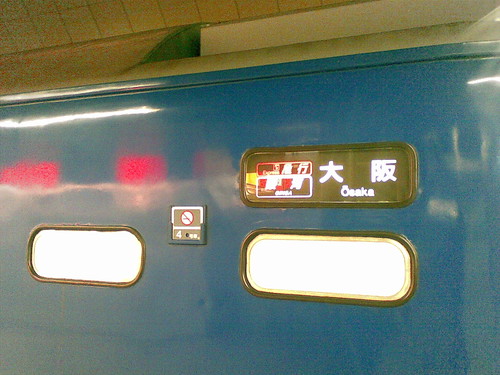
The feeling of nostalgia extends to the interior, with the brass and porcelain washroom.
In standard class the beds are small but adequate, and laid out four to a bay. The curtain provides the only privacy. Night trains are definitely a relic of a time that was less concerned about safety.
The beds come with neatly folded bedding and a yukata robe. There are "indoor slippers" to be worn around the train too. 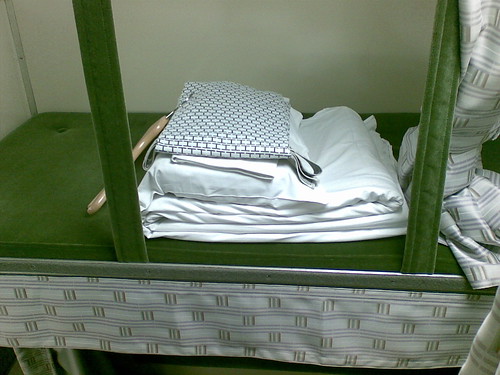
I fastened my curtains, changed into my robe, put in the iPod headphones and fell fast asleep by midnight. When I woke, the sun was rising and we were speeding through the outskirts of Kyoto. There's something very romantic about night trains.
Posted by
Auntie Em
at
2:51 AM
2
comments
![]()
Labels: Japan Exchange, oba em no tabi
Monday, October 08, 2007
On the rails
I've been travelling this weekend. It started with a Shinkansen to Tokyo, where I wandered for hours just getting as lost as possible. The Imperial Palace Gardens and a couple of parks form oases of tranquility, but otherwise Tokyo is a fairly hectic place. However the politeness and good manners of the people there make it much easier to cope with than some other cities of lesser size (I'm looking in your directions, Paris and London!)
The biggest excitement for me was actually leaving Tokyo - I caught the Ginga sleeper. I adore sleeper trains and, whilst it wasn't quite as comfortable as the capsule hotel, my little bunk/tent combo was very conducive to sleep. Waking up just after sunrise whilst travelling though the outskirts of Kyoto was fantastic - seeing the streets empty of cars and the station platforms all but deserted (apart for a few hardy Japanese trainspotters for whom a photo of the Ginga is much prized).
My colleague and friend Larissa and her daughter have been looking after me this weekend. They arrived in Osaka very late on Friday night, so my arrival at the crack of dawn on Saturday wasn't particularly well timed from their point of view! Nevertheless they've been the souls of hospitality. Larissa lived in Osaka for three years and her knowledge is invaluable - I've had to make hardly any effort at all - just follow where I'm led and some astonishing temples or heartbreakingly beautiful gardens or beautiful food is there in front of me.
Photos and videos will follow in a couple of days, with some more details about the temples and shrines that we've seen. I think I may be in love with Japan...
Posted by
Auntie Em
at
12:30 PM
0
comments
![]()
Labels: Japan Exchange, oba em no tabi
Wednesday, October 03, 2007
Around Asakusa and Ueno
Tokyo, days one and two - now with moving pictures.

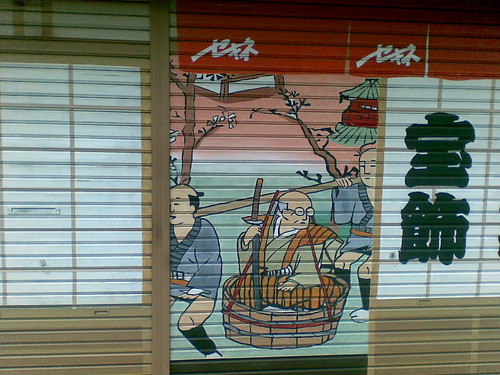
Sunday morning shuttered shops in Asakusa. I'm guessing that vandalism isn't a major problem here.
Rough and ready video of the first couple of days. Best with sound:
Posted by
Auntie Em
at
5:48 PM
0
comments
![]()
Labels: Japan Exchange, oba em no tabi
Why I'm bad for my husband's health
Interesting study on health effects, as reported in MindHacks. I haven't read the full article, as it's behind a Paywall (for anyone with generous Athens access, it's can be found via PubMed) and it may well be an example of Texas Bullseye[1], but the abstract reports that:
After adjusting for age, systolic blood pressure, body mass index, cigarette smoking, diabetes, and total cholesterol/high density cholesterol, the married men compared with unmarried men were almost half as likely to die during follow-up (hazard ratio (HR) = 0.54; 95% confidence interval (CI): 0.34-0.83)... Men with wives who were upset by work were 2.7 times more likely to develop CHD (HR = 2.71; 95% CI: 1.22-6.03).
Hmm. C'mon funding propsal!
[1]The practice of shooting up a barn door with an automatic weapon, drawing a circle round the three closest hits and calling that the bullseye, post-hoc.
Posted by
Auntie Em
at
2:11 AM
0
comments
![]()
Labels: Careers, Home front, Science
Tuesday, October 02, 2007
Shinshoji Temple, Tokyo
The Shinshoji temple is in Asakusa, so I couldn't leave Tokyo without a visit:
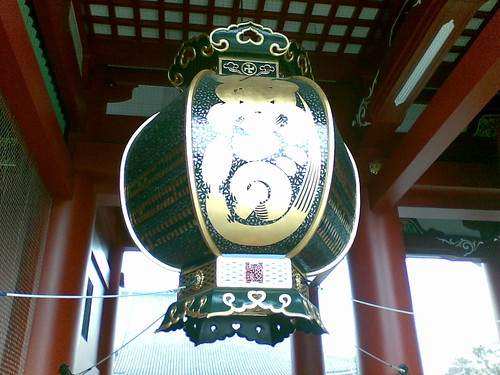
The temple gate.
Worshipers purify themselves in incense smoke before entering the temple.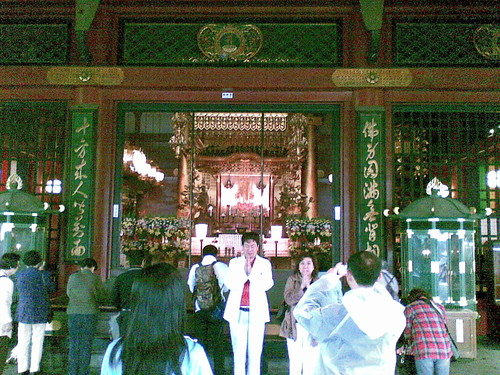
Worshipers complete their devotions by clapping very loudly..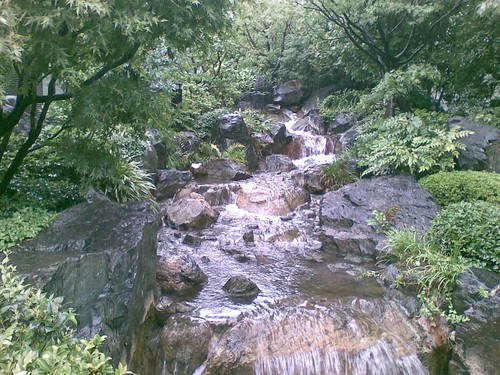
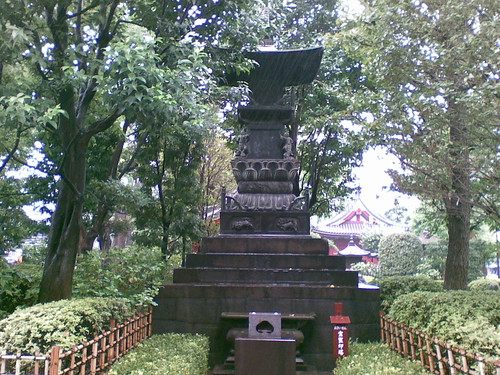

Shinshoji is surrounded by beautiful gardens, shrines and statuary.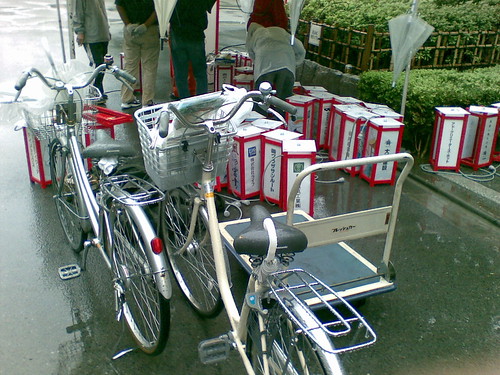
But maintaining them can't be cheap. These new lanterns are sponsored by, and carry the logo of a credit card company.
Posted by
Auntie Em
at
6:31 AM
0
comments
![]()
Labels: Japan Exchange, oba em no tabi
Monday, October 01, 2007
Capuseru Hoteru Asukasa
(Or, カプセルホテル、浅草, if you have Japanese fonts installed!)
Thanks to an excellent bilingual map of Tokyo[1] I knew exactly where to find the capsule hotel, and even which exit to leave Asakusa metro station. Check in was a little more difficult - I'm not used to having to go to a vending machine to pay for my night's stay (I swear to you - an actual vending machine that actually vends an actual ticket that you actually take to the receptionist to exchange for a locker key).
I didn't go out much the first night - I mainly walked around Asakusa, trying to position myself so that David could find me on the webcam:
[Webcam on the cheap - I'm the orange splodge by the phone box!]
By 10 o clock I was attempting my first Japanese bath, and my word was it hot. 40 degrees C sounds quite warm, a few degrees above body temperature but copeable with. Until you try it for the first time. I didn't get in any further than my knees. I've jumped in post-sauna, ice-cold plunge pools with greater alacrity than this, and I don't particularly like the cold. To every lobster I've ever eaten - I'm sorry.
The panoramic baths were only available to men. For some reason, the women's bathing arrangement's didn't involve huge floor to ceiling windows :) There was a common balcony where tea and coffee were available. It made a nice perch to watch the city from.
The heat and journey by this point were enough to make me feel like some capsule time was in order. And that's why you're here, right - to see photos of those crazy capsules. Well wait no longer dear reader: The women's floor bathroom. I may be wrong but I'm assuming the chaps don't get flowers and a hairdryer.
The women's floor bathroom. I may be wrong but I'm assuming the chaps don't get flowers and a hairdryer. Women are assigned a single floor of the nine storey hotel. Not many capsule hotels cater for women at all, as they exist mainly for the convenience of salarymen who've missed the last train home after a night on the sake. Apparently they aren't great company.
Women are assigned a single floor of the nine storey hotel. Not many capsule hotels cater for women at all, as they exist mainly for the convenience of salarymen who've missed the last train home after a night on the sake. Apparently they aren't great company.
On Saturday night, the women's floor was camaraderie personified. Japanese grandmothers visiting grandchildren whose apartments are too small to take guests and lone female travelers sharing stashes of sweets and being sweetly considerate about noise.
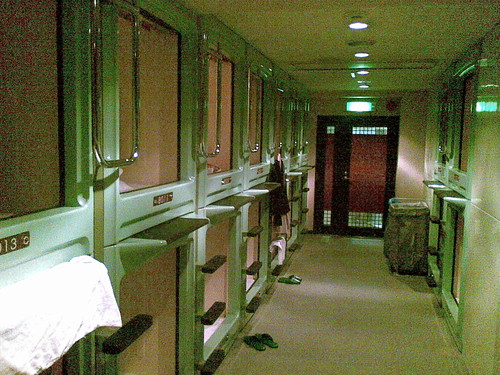 The capsules themselves were somewhat hivelike. I do think this is what the first spaceships to colonise other planets will look like. I've always thought that the living conditions on Red Dwarf were much more plausible than the ones on the Enterprise.
The capsules themselves were somewhat hivelike. I do think this is what the first spaceships to colonise other planets will look like. I've always thought that the living conditions on Red Dwarf were much more plausible than the ones on the Enterprise.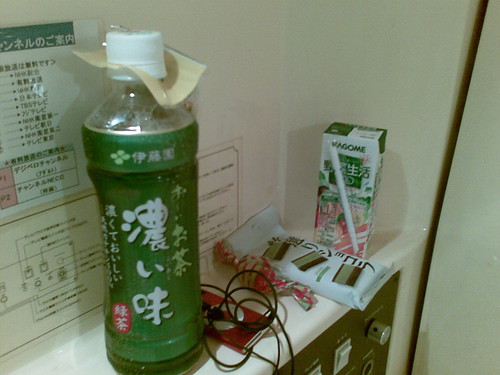
The capsule interior feels surprisingly spacious - there was room to sit and read, and to watch some Simpsons on the laptop. The radio unit doubles as a handy shelf and the dimmable light makes things very cosy indeed. Nothing about the experience felt in any way strange, and the capsule was easily big enough for someone of my height (5'10"). I've never slept so well on my first night anywhere.
The photos of the inside of the capsule don't do it any justice, but I have some video coming up that will show you a capsule in all its glory. I'm off to explore Sendai.
[1] Tokyo City Atlas: A Bilingual Guide, Kidansha International, 2004. ISBN-13: 978-4-7700-2503-6. I got mine from Stanfords.
Posted by
Auntie Em
at
12:41 AM
0
comments
![]()
Labels: Japan Exchange, oba em no tabi

